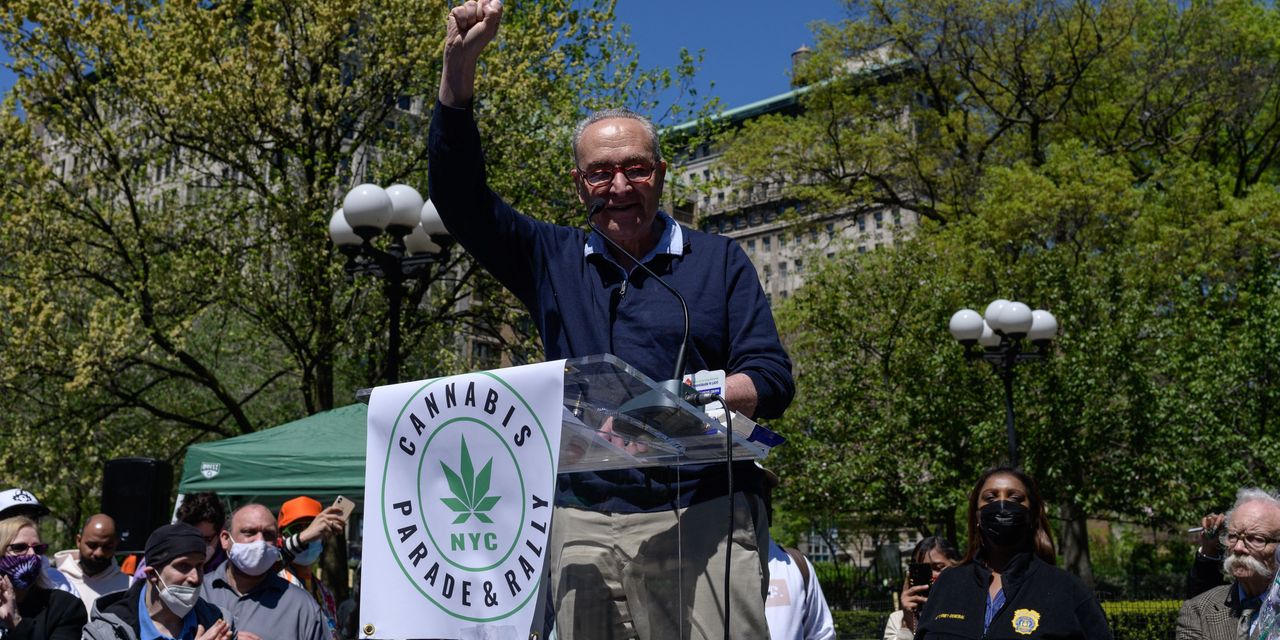Sen. Chuck Schumer on Thursday introduced a bill to tax and regulate cannabis and remove it from the federal list of controlled substances, but while it’ll open up the marijuana debate on Capitol Hill, the measure is not expected to pass.
It would also expunge records of people with low-level cannabis convictions and raise money to provide capital to entrepreneurs in the industry.
“For far too long, the federal prohibition on cannabis and the War on Drugs has been a war on people, and particularly people of color,” Schumer said.
The Cannabis Administration and Opportunity Act (CAOA) from Senate Majority Leader Schumer, a New York Democrat, Senate Finance Committee Chair Ron Wyden, A Democrat from Oregon, and Sen. Cory Booker, a New Jersey Democrat, would also ensure that cannabis companies legal at state level would no longer be denied bank accounts or financial services.
The bill is not expected to get the 60 votes needed to pass the Senate, Politico reported. President Joe Biden has also said he does not support cannabis legalization.
As proposed in the CAOA bill, the Drug Enforcement Administration would no longer have jurisdiction over cannabis. That would fall to the U.S. Food and Drug Administration, as well as the Alcohol and Tobacco Tax and Trade Bureau (TTB) within the Treasury Department.
The FDA would be required to establish health and safety standards, set up an office of cannabis products and support a 21-year-old age limit on cannabis use.
Wyden said Congress “needs to get with the program” after states have led the way on cannabis reform.
“By failing to act, the federal government is empowering the illicit cannabis market, it’s ruining lives and propping up deeply rooted racism in our criminal justice system, it’s holding back small cannabis businesses from growing and creating jobs in their communities,” Wyden said.
The bill proposes to end discrimination on benefits such as federal housing or federal student loans on the basis of cannabis use. Other measures include the creation of a standard for cannabis-impaired driving by the Dept. of Transportation and data collection on cannabis-impaired drivers by the National Highway Traffic Safety Administration.
The bill proposes a 5% to 12.5% excise tax for small- and mid-sized cannabis producers. It would charge an initial tax of 10% on larger cannabis businesses and gradually increase it to 25%.
Meanwhile, the cannabis spotlight on Capitol Hill shifts to a hearing on Tuesday afternoon entitled “Decriminalizing Cannabis at the Federal Level: Necessary Steps to Address Past Harms” by the Subcommittee on Criminal Justice and Counterterrorism.
Cannabis advocates welcomed the Schumer pot bill more than a year after a draft version was released and then drew about 1,800 comments.
U.S. Cannabis Council CEO Steven Hawkins said Schumer’s bill “is the strongest sign yet that cannabis prohibition in America is nearing its end.”
Some of the banking provisions in the bill have already been proposed in the SAFE Banking legislation that’s passed the U.S. House of Representatives seven times in various forms including a July 14 vote.
Social justice initiatives in the bill come after similar efforts in state programs, particularly in Schumer’s home state of New York
Also Read: New York’s new cannabis chief vows that half of legal licenses will go to social justice efforts
A majority of Americans supported cannabis legalization for the first time in 2013, according to data from Gallup. In 2021, 68% of Americans supported legalizing marijuana, matching the all-time record from 2020.
A total of 19 states allow adult use of cannabis for anyone 21 or older and 38 states run medical marijuana programs. Those numbers could increase with ballot measures and other initiatives on tap.
The AdvisorShares Pure US Cannabis ETF
MSOS,
fell about 2% on Thursday. It’s down 53.2% in 2022, compared to a drop of about 24% by the Nasdaq.



